- Главная
- Разное
- Бизнес и предпринимательство
- Образование
- Развлечения
- Государство
- Спорт
- Графика
- Культурология
- Еда и кулинария
- Лингвистика
- Религиоведение
- Черчение
- Физкультура
- ИЗО
- Психология
- Социология
- Английский язык
- Астрономия
- Алгебра
- Биология
- География
- Геометрия
- Детские презентации
- Информатика
- История
- Литература
- Маркетинг
- Математика
- Медицина
- Менеджмент
- Музыка
- МХК
- Немецкий язык
- ОБЖ
- Обществознание
- Окружающий мир
- Педагогика
- Русский язык
- Технология
- Физика
- Философия
- Химия
- Шаблоны, картинки для презентаций
- Экология
- Экономика
- Юриспруденция
Что такое findslide.org?
FindSlide.org - это сайт презентаций, докладов, шаблонов в формате PowerPoint.
Обратная связь
Email: Нажмите что бы посмотреть
Презентация на тему Intercultural Communication GLOBE studies of 62 Societies
Содержание
- 2. Learning outcomesBeing global is not just about
- 3. Aspects of Globalization of BusinessThe increase of
- 4. Differing Views and Conceptualizations of LeadershipAmericans, Arabs,
- 5. Uncertainty Avoidance Based on questionnaire responses from
- 6. The GLOBE StudyPower DistanceUncertainty AvoidanceHumane OrientationCollectivism I: (Institutional)Collectivism II: (In-Group)AssertivenessGender EgalitarianismFuture OrientationPerformance Orientation
- 7. Globe9 cultural dimensions 7 point scaleLeadership dimensions10
- 8. Cultural dimension definitionsSource: the GLOBE studies, page 250
- 9. 1. Performance orientation conceptPerformance orientation reflects the
- 10. 1. Higher Performance Orientation Societies Versus Lower Performance Orientation SocietiesSource: the GLOBE studies, page 245
- 11. 1. Performance Orientation: Society Values Source: the GLOBE studies, page 250
- 12. 1. Performance Orientation: Society PracticesSource: the GLOBE studies, page 250
- 13. 1. The correlation between overall practices and
- 14. 1. Comparative analysis of values and practices in Russia
- 15. 1. Performance orientation ConclusionIn the sense that
- 16. 2. Future orientation conceptFuture orientation has been
- 17. 2. Higher Performance Orientation Societies Versus Lower Performance Orientation SocietiesSource: the GLOBE studies, page 302
- 18. 2. Future Orientation: Society Values Source: the GLOBE studies, page 306
- 19. 2. Future Orientation: Society PracticesSource: the GLOBE studies, page 304
- 20. 2. The correlation between overall practices and
- 21. Comparative analysis of values and practices in Russia
- 22. 2. Future orientation ConclusionsSocieties that are future
- 23. 3. Gender Egalitarianism conceptHuman beings are
- 24. 3. Higher Gender Egalitarianism Societies Versus Lower Performance Orientation SocietiesSource: the GLOBE studies, page 359
- 25. 3. Gender Egalitarianism : Society Values Source: the GLOBE studies, page 366
- 26. 3. Gender Egalitarianism : Society PracticesSource: the GLOBE studies, page 365
- 27. 3. The correlation between overall practices and
- 28. Comparative analysis of values and practices in Russia
- 29. 3. Gender Egalitarianism ConclusionsThe more gender
- 30. 4. Assertiveness conceptcultural assertiveness reflects beliefs as
- 31. 4. Higher Assertiveness Societies Versus Lower Assertiveness SocietiesSource: the GLOBE studies, page 405
- 32. 4. Assertiveness : Society Values Source: the GLOBE studies, page 411
- 33. 4. Assertiveness : Society PracticesSource: the GLOBE studies, page 410
- 34. 4. The correlation between overall practices and
- 35. Comparative analysis of values and practices in Russia
- 36. 4. Assertiveness: ConclusionsOrganizations reflect Assertiveness cultural
- 37. 5-6. Individualism and Collectivism concept of GLOBE
- 38. 5-6. Higher Individualism-Collectivism versus Lower Individualism-Collectivism SocietiesSource: the GLOBE studies, page 454
- 39. 5-6.Societal Institutional Collectivism Values Source: the GLOBE studies, page 470
- 40. 5-6.Societal In-Group Collectivism Values Source: the GLOBE studies, page 471
- 41. 5-6. Societal Institutional Collectivism PracticesSource: the GLOBE studies, page 468
- 42. 5-6. Societal In-Group Collectivism PracticesSource: the GLOBE studies, page 469
- 43. 5-6. The correlation between overall practices and
- 44. Comparative analysis of values and practices in Russia
- 45. Comparative analysis of values and practices in Russia
- 46. 5-6. Individualism and Collectivism ConclusionsGLOBE's culture (i.e.,
- 47. 7. Power distance conceptThis dimension reflects the
- 48. 7. Higher Power Distance Societies Versus Lower Power Distance SocietiesSource: the GLOBE studies, page 536
- 49. 7. POWER DISTANCE : Society Values Source: the GLOBE studies, page 540
- 50. 7. POWER DISTANCE : Society Practices Source: the GLOBE studies, page 539
- 51. 7. The correlation between overall practices and
- 52. Comparative analysis of values and practices in Russia
- 53. 7. POWER DISTANCE: ConclusionsWithin the high
- 54. 8. Humane Orientation conceptAccording to culture
- 55. 8. Higher Humane Orientation Societies Versus Lower Humane Orientation SocietiesSource: the GLOBE studies, page 570
- 56. 8. Humane Orientation : Society ValuesSource: the GLOBE studies, page 539Source: the GLOBE studies, page 574
- 57. 8. Humane Orientation : Society Practices Source: the GLOBE studies, page 573
- 58. 8. The correlation between overall practices and
- 59. Comparative analysis of values and practices in Russia
- 60. 9. Humane Orientation : ConclusionsHumane orientation
- 61. 9. Uncertainty avoidance conceptUncertainty avoidance involves the
- 62. 9. Higher Uncertainty Avoidance Societies Versus Lower Uncertainty Avoidance SocietiesSource: the GLOBE studies, page 570
- 63. 9. Uncertainty Avoidance : Society ValuesSource: the GLOBE studies, page 622
- 64. 9. Uncertainty Avoidance : Society Practices Source: the GLOBE studies, page 623
- 65. 9. The correlation between overall practices and
- 66. Comparative analysis of values and practices in Russia
- 67. 9. Uncertainty Avoidance : ConclusionsThe data
- 68. Скачать презентацию
- 69. Похожие презентации
Learning outcomesBeing global is not just about where you do business. It is also about how you do it.



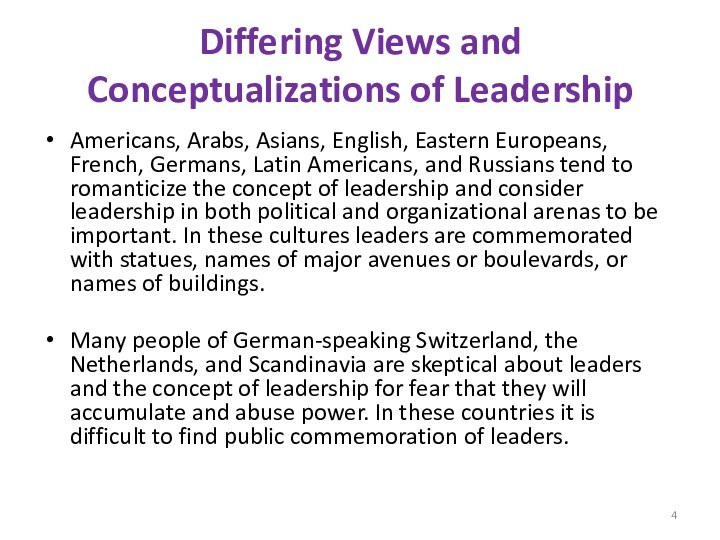








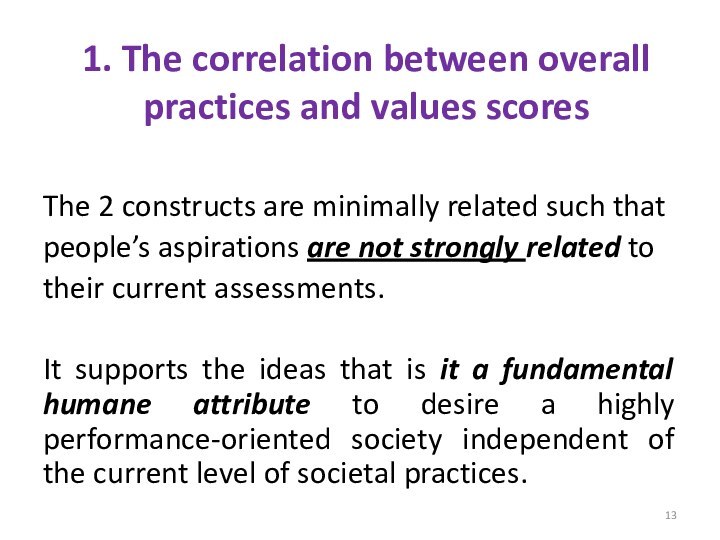





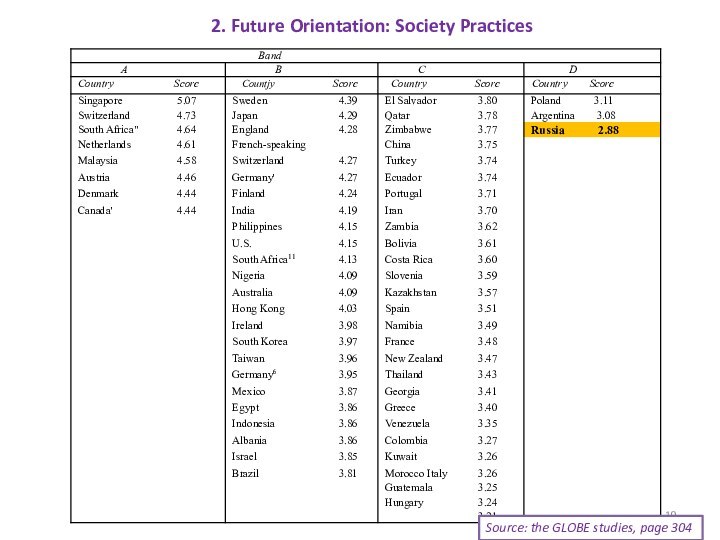





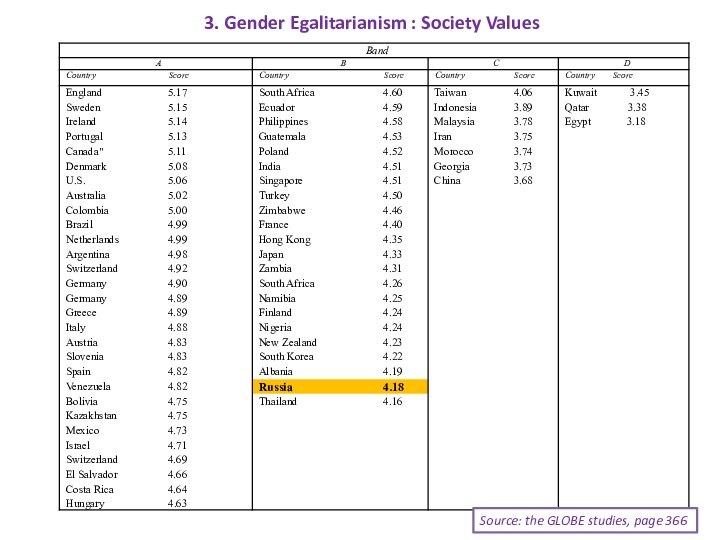










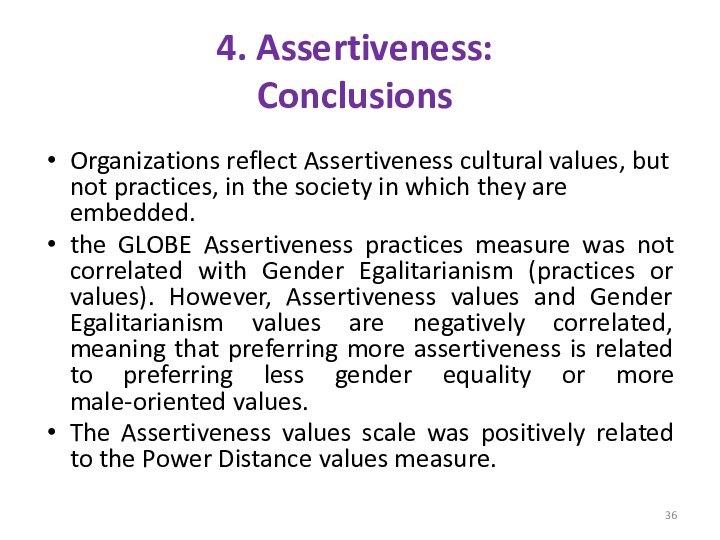











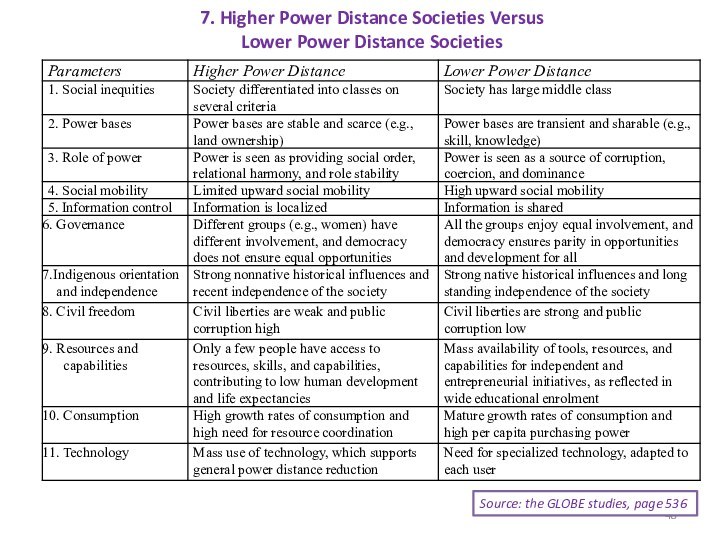







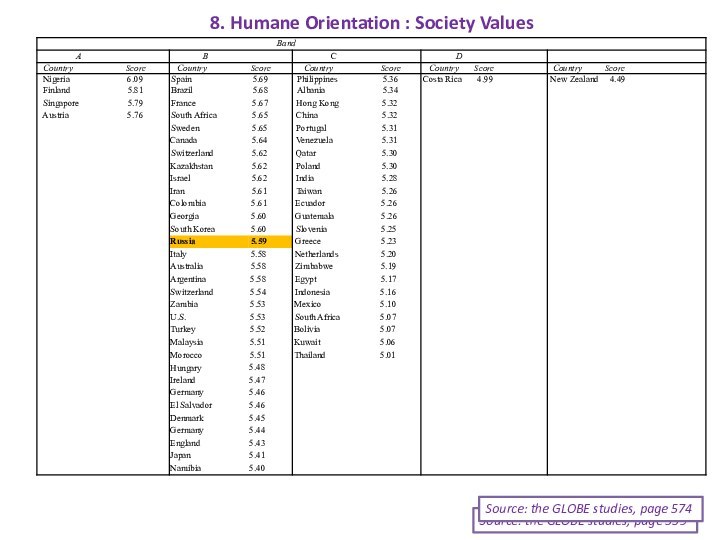

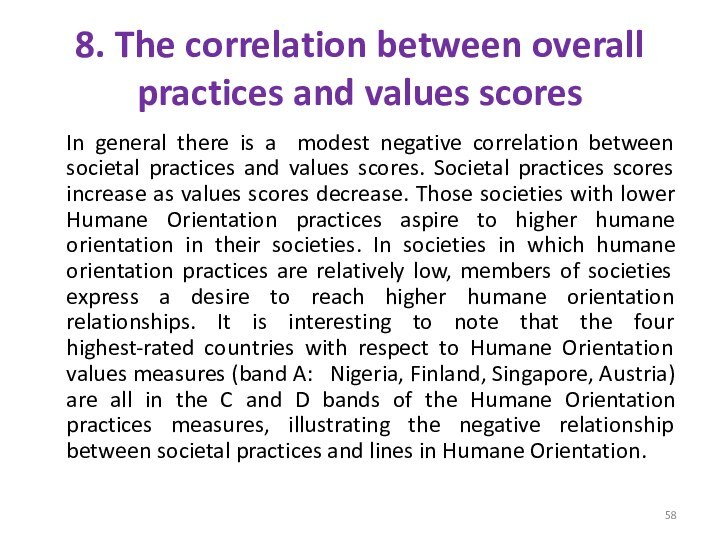
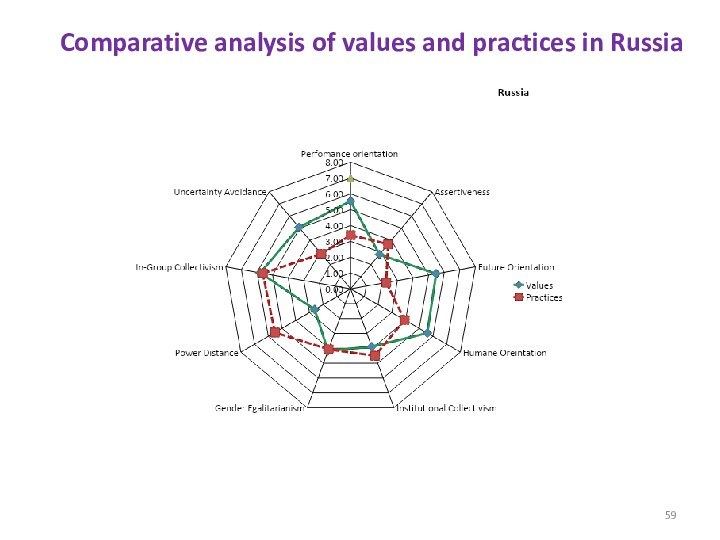





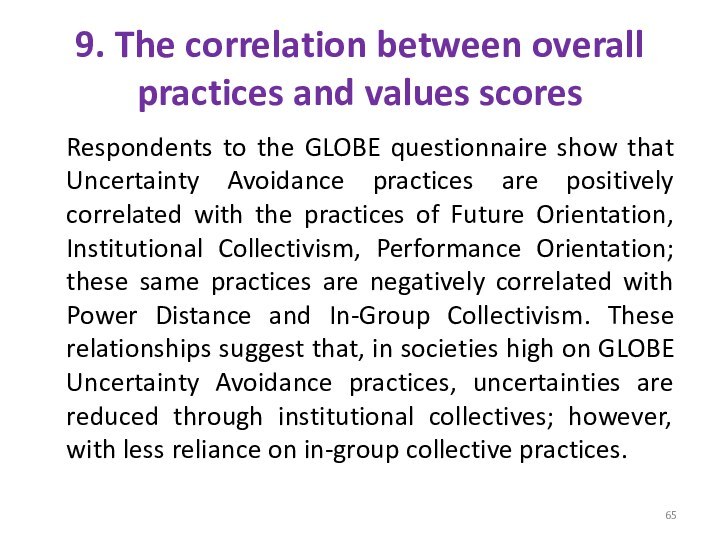



Слайд 3
Aspects of Globalization of Business
The increase of foreign
customers and foreign competitors
Travel and tourism
The number of
Internet users The increase o international flow of investment
Globalization of financial markets
Unprecedented growth of cross-border M&A trasaction
Hence facing incrasing global employees, Customers, Suppliers, copetitors , creditors
Слайд 4
Differing Views and Conceptualizations of Leadership
Americans, Arabs, Asians,
English, Eastern Europeans, French, Germans, Latin Americans, and Russians
tend to romanticize the concept of leadership and consider leadership in both political and organizational arenas to be important. In these cultures leaders are commemorated with statues, names of major avenues or boulevards, or names of buildings.Many people of German-speaking Switzerland, the Netherlands, and Scandinavia are skeptical about leaders and the concept of leadership for fear that they will accumulate and abuse power. In these countries it is difficult to find public commemoration of leaders.
Слайд 5
Uncertainty Avoidance
Based on questionnaire responses from about
17,000 managers in 62 societies, our findings reveal that
there is wide variation among societies on this dimension, ranging from 2.88 to 5.37 on a seven-point scale. Examples of societies that are very high on the tendency to avoid uncertainty are China, Singapore, and German-speaking and Scandinavian countries. Examples of societies that are very low on this tendency are the Latin American countries, and the Eastern European countries.Now consider how individuals in high and low uncertainty avoidance cultures tend to behave. Most individuals in high uncertainty avoidance cultures have a strong tendency toward formalizing their interactions with others, documenting agreements in legal contracts, being orderly, keeping meticulous rxecords, documenting conclusions drawn in meetings, formalizing policies and procedures, establishing and following rules, verifying verbal communications in writing, and taking moderate calculated risks.
In contrast, most individuals in low uncertainty avoidance cultures tend to exhibit the following traits and practices: they are more informal; rely on the word of others they trust rather than contractual arrangements; are less concerned with orderliness and the maintenance of records; do not document the conclusions drawn in meetings; rely on informal interactions and informal norms rather than formalized policies, procedures, and rales; and tend to be less calculating when taking risks.
If individuals from high and low uncertainty avoidance cultures are aware of their differences with respect to this cultural dimension, they will more likely know what to expect from each other, and possibly be able to negotiate mutually agreeable approaches to conflict resolution, problem solving, decision making, and management practices.
Слайд 6
The GLOBE Study
Power Distance
Uncertainty Avoidance
Humane Orientation
Collectivism I:
(Institutional)
Collectivism II: (In-Group)
Assertiveness
Gender Egalitarianism
Future Orientation
Performance Orientation
Слайд 7
Globe
9 cultural dimensions
7 point scale
Leadership dimensions
10 cultural
clusters
The correlation for each dimension between the reported values
and practices
Слайд 9
1. Performance orientation
concept
Performance orientation reflects the extent to
which a community encourages and rewards innovation, high standards,
perfomance improvement.Слайд 10 1. Higher Performance Orientation Societies Versus Lower Performance
Orientation Societies
Source: the GLOBE studies, page 245
Слайд 13 1. The correlation between overall practices and values
scores
The 2 constructs are minimally related such that
people’s
aspirations are not strongly related totheir current assessments.
It supports the ideas that is it a fundamental humane attribute to desire a highly performance-oriented society independent of the current level of societal practices.
Слайд 15
1. Performance orientation
Conclusion
In the sense that cultural values
of performance
orientation exist more strongly among some
peoples than others,
and are a critical force inshaping and influencing their social and
economic behavior.
Слайд 16
2. Future orientation
concept
Future orientation has been identified as
a dimension of the more general construct, time orientation,
that relates to the subjective experience of time (Trommsdorff, 1983).Cultural future orientation is the degree to which a collectivity encourages and rewards future-oriented behaviors such as planning and delaying gratification (House et al., 1999).
Слайд 17 2. Higher Performance Orientation Societies Versus Lower Performance
Orientation Societies
Source: the GLOBE studies, page 302
Слайд 20 2. The correlation between overall practices and values
scores
Societal scores on the Future Orientation values scale
are negatively correlated with the scores on the Future Orientation practices state. The negative correlations indicate that the lower the practices score, the higher the reported value of Future Orientation.The negative correlations societies reporting weaker practices of Future Orientation have stronger aspirations for FO. It may be that societies lacking FO practices suffer most form the uncertainty of not addressing the longer-term fundamental issues. Such societies are most conscious of the need for moving toward a more strategic and spiritually fulfilling perspective.
Слайд 22
2. Future orientation
Conclusions
Societies that are future oriented likely
have organizations within them that are also future oriented.
Industrialized
and higher-income nations enjoy the present more and are not overly concerned about a future orientation because they have already accumulated substantial wealth and material resources. The emerging and lower-income nations may, on the other hand, see a stronger need for taking a long-term perspective and sacrificing for the future because they must cope with scarce and limited resources.
Слайд 23
3. Gender Egalitarianism
concept
Human beings are complex, social
creatures capable of assuming multiple roles at any given
time and over the course of their lives.One of the most fundamental ways in which societies differ is in the extent to which each prescribes and proscribes different roles for women and men (Hofstede, 1980, 1998).
Some societies are more gender egalitarian and seek to "minimize gender role differences" (House et al., 1999), whereas other societies are more gender differentiated and seek to maximize such differences.
Слайд 24 3. Higher Gender Egalitarianism Societies Versus Lower Performance
Orientation Societies
Source: the GLOBE studies, page 359
Слайд 27 3. The correlation between overall practices and values
scores
Managers' perceptions of their societies' practices and values
with respect to Gender Egalitarianism are significantly correlated. The more gender egalitarian a society‘s current practices, the more gender egalitarian a manager's values.
Слайд 29
3. Gender Egalitarianism
Conclusions
The more gender egalitarian a
society, the less it relies on biology to determine
women's and men's social roles.This construct varies along a continuum in that societies can be rated as more or less gender egalitarian relative to other societies in the same study.
More gender egalitarian societies believe that men and women are suited for similar roles, whereas less gender egalitarian societies believe that men and women should assume different roles.
Слайд 30
4. Assertiveness
concept
cultural assertiveness reflects beliefs as to whether
people are or should be encouraged to be assertive,
aggressive, and tough, or nonassertive, aggressive, and tender in social relations.According to Hofstede aggressive carries a positive connotation only in what he calls masculine countries.
non –assertive
assertive
aggressive
rationality
pragmatism
Слайд 31
4. Higher Assertiveness Societies Versus
Lower Assertiveness Societies
Source:
the GLOBE studies, page 405
Слайд 34 4. The correlation between overall practices and values
scores
the desire for less Assertiveness, perhaps reflecting
the wish to belong to a relatively nonthreatening, nonaggressive society. However, as stated, a third of the countries seem to want more Assertiveness, and many Asian countries, especially, stress assertiveness in this regard.Those societies that score higher on Assertiveness values show
the following characteristics (significant correlation coefficiencies):
They have more success in science and technology
They have more respect for family and friends
They are lower on egalitarian commitment
Слайд 36
4. Assertiveness:
Conclusions
Organizations reflect Assertiveness cultural values, but
not practices, in the society in which they are
embedded.the GLOBE Assertiveness practices measure was not correlated with Gender Egalitarianism (practices or values). However, Assertiveness values and Gender Egalitarianism values are negatively correlated, meaning that preferring more assertiveness is related to preferring less gender equality or more male-oriented values.
The Assertiveness values scale was positively related to the Power Distance values measure.
Слайд 38
5-6. Higher Individualism-Collectivism versus
Lower Individualism-Collectivism Societies
Source: the
GLOBE studies, page 454
Слайд 43 5-6. The correlation between overall practices and values
scores
the In-Group Collectivism practices scale is the most
highly correlated with other well-established societal-level collectivism scales in the literature. it is also evident that GLOBE's Institutional Collectivism practices scale seems to measure a different aspect of collectivism from those previously examined at the societal level of analysis. For example, as discussed in the previous section, Institutional Collectivism practices seem to be part of a cultural syndrome wherein such cultures are future focused and performance oriented yet seek to accomplish such orientations through practices that emphasize being concerned about others, and not being assertive or power dominating.
Слайд 46
5-6. Individualism and Collectivism
Conclusions
GLOBE's culture (i.e., nation) scores
for In-Group Collectivism are very highly and inversely correlated
with Hofstede's (1980) nation scores on individualism.The GLOBE data reveal, however, that variability in values and practices of In-Group Collectivism is alive and well at the societal level despite changes in world economic and political activity. Of course, it is not possible to state that specific cultures have not changed; we can state only that the rankings of cultures with respect to collectivism have generally not changed. Nevertheless, GLOBE provides compelling evidence of the diversity of culture at the societal level when it comes to In-Group Collectivism.
Слайд 47
7. Power distance
concept
This dimension reflects the extent to
which a community accepts and endorses Minority, power differences,
and status privileges. It is an important aspect of a community's Culture and has been related to a variety of behaviors in organizations and societies.Слайд 48 7. Higher Power Distance Societies Versus Lower Power
Distance Societies
Source: the GLOBE studies, page 536
Слайд 51 7. The correlation between overall practices and values
scores
In societies with high Power Distance practices
scores, respondents prefer a more equitable distribution of power. In contrast, in societies with low Power Distance practices scores, respondents prefer a less equitable distribution of power. the correlation coefficient between societal practices and values of Power Distance is insignificant at 0.02 (p > .05).
Слайд 53
7. POWER DISTANCE:
Conclusions
Within the high power distance
cultures of the East, the stable distribution of power
is expected to bring order to the society and to allow unambiguous allocation of roles and rigid structure of relationships. The clearly dysfunctional element of HIGH PD is a little opportunity for debate and voicing of divergent views. Asking questions may be interpreted or regarded as criticizing and blaming, and therefore may be prohibited.Low power distance cultures of the West, the flexible distribution of power is expected to facilitate entrepreneurial innovation, to allow broader participation in education, and to constrain the abuse of power and corruption.
There are significant variations in the practice and preference of power distance in both Eastern and Western societies, which indicates that the dominant expectations in these regions are largely historically derived.
Слайд 54
8. Humane Orientation
concept
According to culture theory (Triandis,
1995) values of altruism, benevolence, kindness, love, and generosity
are salient as motivating factors guiding people's behavior in societies characterized by a strong humane orientation. In these societies, the need for belongingness and affiliation, rather than self-fulfillment, pleasure, material possessions, and power, are likely to be the dominant motivating bases.Слайд 55 8. Higher Humane Orientation Societies Versus Lower Humane
Orientation Societies
Source: the GLOBE studies, page 570
Слайд 56
8. Humane Orientation : Society Values
Source: the GLOBE
studies, page 539
Source: the GLOBE studies, page 574
Слайд 58 8. The correlation between overall practices and values
scores
In general there is a modest negative
correlation between societal practices and values scores. Societal practices scores increase as values scores decrease. Those societies with lower Humane Orientation practices aspire to higher humane orientation in their societies. In societies in which humane orientation practices are relatively low, members of societies express a desire to reach higher humane orientation relationships. It is interesting to note that the four highest-rated countries with respect to Humane Orientation values measures (band A: Nigeria, Finland, Singapore, Austria) are all in the C and D bands of the Humane Orientation practices measures, illustrating the negative relationship between societal practices and lines in Humane Orientation.
Слайд 60
9. Humane Orientation :
Conclusions
Humane orientation is operationalized
as the degree of concern, sensitivity, friendship, tolerance, and
support that is extended to others at the societal, organizational, and leadership levels. Highly humane-oriented behaviors include care, nurturance, and help to others, whereas low humane orientation involves promoting self-interest and lack of consideration. Humane orientation of societies is closely related to the economic, physical, and psychological well-being of their members. Different societies, organizations, and leaders place varying emphasis on I he-breadth of support that is extended to others.
Слайд 61
9. Uncertainty avoidance
concept
Uncertainty avoidance involves the extent to
which ambiguous situations are threatening to individuals, to which
rules and order are preferred, and to which uncertainty is tolerated in a society.Слайд 62 9. Higher Uncertainty Avoidance Societies Versus Lower Uncertainty
Avoidance Societies
Source: the GLOBE studies, page 570
Слайд 65 9. The correlation between overall practices and values
scores
Respondents to the GLOBE questionnaire show that
Uncertainty Avoidance practices are positively correlated with the practices of Future Orientation, Institutional Collectivism, Performance Orientation; these same practices are negatively correlated with Power Distance and In-Group Collectivism. These relationships suggest that, in societies high on GLOBE Uncertainty Avoidance practices, uncertainties are reduced through institutional collectives; however, with less reliance on in-group collective practices.
Слайд 67
9. Uncertainty Avoidance :
Conclusions
The data suggest that
societies with high scores for
GLOBE Uncertainty Avoidance practices tend
to have ahigher level of economic prosperity and enjoy more
civil liberties, a higher level of competitiveness in the
global market, greater security, higher life expectancy,
and greater general satisfaction. Higher Uncertainty
Avoidance practices were also related to more
emphasis on basic science and research.





























